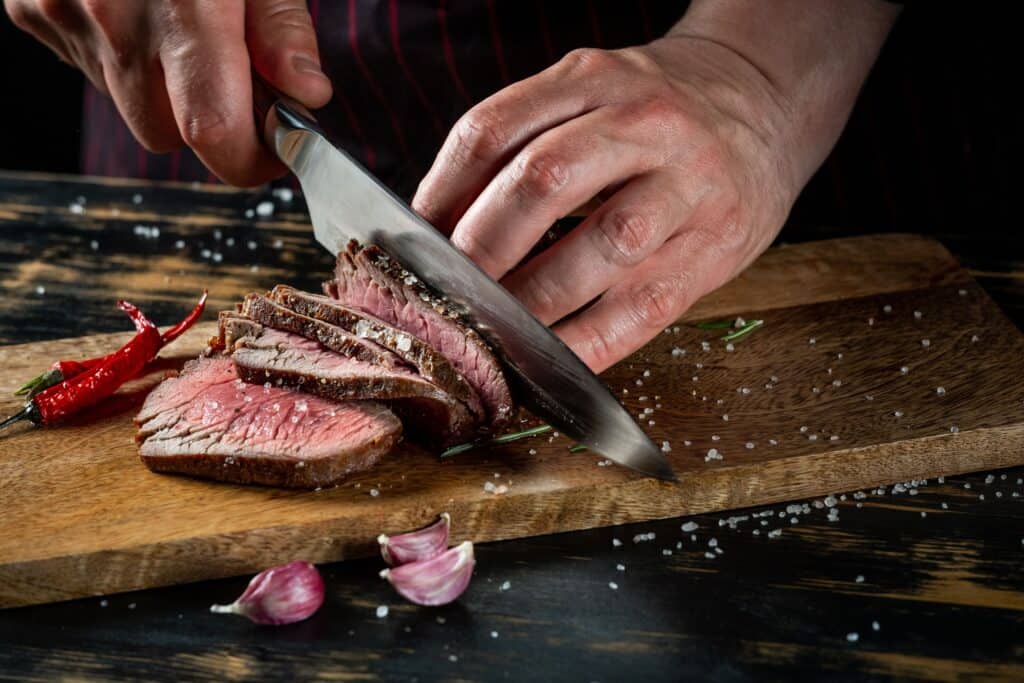Plastic vs. Wood Cutting Boards: Which Is The Better Choice?
When it comes to food preparation, choosing the right cutting board is as crucial as selecting the right knife. Whether you’re slicing vegetables or carving meat, the cutting board you use can significantly impact your kitchen experience. The debate between plastic and wood cutting boards has been ongoing, with both materials offering unique advantages. But which one truly stands out? In this guide, we’ll dissect the differences between plastic and wood cutting boards, so you can make the best choice for your kitchen, ensuring safety, durability, and ease of use.
Choice Matters

There are pros and cons to both wood and plastic boards, and ultimately, you as the consumer and cook get to make the decision. We hope to help you make that decision clearer.
Pros of Plastic Cutting Boards

- Ease of Cleaning: Plastic cutting boards are dishwasher-safe, making them easy to sanitize. This is particularly important for preventing cross-contamination when handling raw meat or poultry.
- Affordable and Accessible: Plastic cutting boards are generally more affordable than wood alternatives and are widely available in various sizes and colors.
- Gentle on Knives: High-quality plastic boards are less likely to dull your knives compared to harder surfaces like glass or ceramic.
- Some Can Be Recycled: Some plastic cutting boards can be recycled, depending on the material. Check with your local recycling program to see if they accept them.
- Not All Plastic Are The Same: Plastic cutting boards range from super thin, flexible types, to thicker ones that have some give for your knives. Read reviews. We prefer the ones that are not super hard.
Cons of Plastic Cutting Boards

- Surface Damage: Over time, plastic boards can develop deep grooves from knife cuts. These grooves can harbor bacteria, even after thorough cleaning. This can mean they have to be replaced more often.
- Less Aesthetic Appeal: Unlike wood, plastic boards may lack the visual appeal that enhances a kitchen’s ambiance.
- Environmental Impact: Most plastic boards are made from petroleum-based materials, which are not biodegradable and contribute to environmental pollution.
Pros of Wood Cutting Boards

- Natural Antibacterial Properties: Certain types of wood, such as maple and walnut, have natural antimicrobial properties, making them a safer option for food preparation.
- Durability: Wood cutting boards are sturdy and can last for many years if properly maintained. They are also less prone to deep cuts that can trap bacteria.
- Aesthetic Appeal: Wooden boards add a warm, rustic charm to your kitchen, and they can double as serving platters for cheeses and bread.
Cons of Wood Cutting Boards

- Maintenance: Wood boards require regular oiling to prevent cracking and warping. They also can’t be cleaned in a dishwasher, requiring more manual upkeep.
- Heavier and Bulkier: Wood cutting boards are typically heavier than plastic ones, making them less convenient to move around or store.
- Cost: High-quality wooden boards can be significantly more expensive than plastic alternatives, which may not be ideal for budget-conscious shoppers.
Which Cutting Board is Safer?

Safety is a top concern when choosing a cutting board, particularly when it comes to preventing foodborne illnesses. Both plastic and wood boards have been scrutinized for their ability to harbor bacteria, but studies have shown mixed results.
- Plastic Cutting Boards: While plastic boards are easy to sanitize, they can develop deep knife grooves that trap bacteria, making thorough cleaning challenging over time.
- Wood Cutting Boards: Wood’s porous nature might seem like a drawback, but certain woods have self-healing properties that close up knife cuts, making it difficult for bacteria to hide. Additionally, the natural antibacterial properties of wood can reduce bacterial survival rates.
Can you use the same cutting board for meat and vegetables?

It’s recommended to use separate cutting boards for raw meat and vegetables to avoid cross-contamination. If you only have one board, clean it thoroughly between uses.
Environmental Considerations

If sustainability is a priority for you, the choice between plastic and wood cutting boards becomes clearer.
- Plastic Cutting Boards: Most plastic boards are made from non-renewable resources and do not decompose, contributing to landfill waste. However, some companies are now producing boards from recycled or recyclable materials, which can reduce environmental impact.
- Wood Cutting Boards: Wood is a renewable resource, and when sourced responsibly, it has a lower environmental impact. Wooden boards are also biodegradable, making them an eco-friendlier option.
Are bamboo cutting boards better than wood?

Bamboo cutting boards are more eco-friendly and harder than most woods, but they can be more damaging to your knives.
Which Cutting Board Should You Choose?

Ultimately, the choice between plastic and wood cutting boards depends on your priorities. If ease of cleaning and affordability are your main concerns, plastic might be the best option. However, if you value durability, aesthetics, and environmental impact, a wood cutting board is likely the better choice. By understanding the strengths and weaknesses of each material, you can make an informed decision that suits your cooking style and kitchen needs.
The 15 Canned Products Even Chefs Use At Home

Having been a professional recipe developer for over 30 years, I know my way in and out of commercial kitchens as well as the home kitchens. While some ingredients and pieces of equipment are more common in the professional environment, there is certainly overlap. These are the canned foods that professional chefs love and use any time they are cooking. These canned goods should be in your pantry. READ: The 15 Canned Products Even Chefs Use At Home
Unlocking The Power Of Fermented Foods For Gut Health

More people are increasingly mindful of their health, with a growing interest in understanding the role of the gut microbiome in promoting overall well-being. The consumption of fermented foods has garnered considerable attention as a way to support a healthy gut ecosystem. The idea of “fermented” foods might seem odd at first, but most of us are familiar with traditional pickles, and yogurt, to name possibly the two most common fermented items in the supermarket, and perhaps your own refrigerator. There is a diverse array of fermented foods that have the potential to transform and enhance your gut health – and to bring flavor to your meals. We have what you need to know!
Join Us

Join us on this empowering journey as we explore, celebrate, and elevate “her story.” The Queen Zone is not just a platform; it’s a community where women from all walks of life can come together, share their experiences, and inspire one another. Welcome to a space where the female experience takes center stage. Sign up for our newsletter so you don’t miss a thing, Queen!







